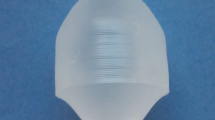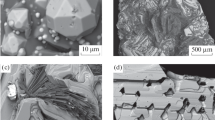Abstract
The standard enthalpy of formation of sodium dimolybdate was determined by dissolution calorimetry based on the measured enthalpies of dissolution of Na2CO3, MoO3, and Na2Mo2O7 in a 0.2 M NaOH solution and the literature data: ΔfH0(Na2Mo2O7, 298.15 K) = −2245.3 ± 6.3 kJ/mol. The lattice enthalpy was calculated using the Born–Haber cycle: –54 730 kJ/mol. The wavelength of luminescence radiation decreased from 650 to 540 nm on passing from sodium molybdate to sodium tungstate, and the lattice enthalpy decreased from –54 730 kJ/mol (Na2Mo2O7) to –49 030 kJ/mol (Na2W2O7). The temperature dependence of the heat capacity of sodium dimolybdate was determined in the temperature range 320–785 K. There are no phase transitions in this range.




Similar content being viewed by others
REFERENCES
H. Kim, I. R. Pey, A. Khan, et al., Cryst. Res. Technol. 54, 1900079 (2019).
F. Xu, G. Zhang, M. Luo, G. Peng, et al., Nat. Sci. Rev. 8, 1 (2021).
P. Chen, Y. Chen, L. Jiang, et al., J. Alloys Compd. 784, 370 (2019).
A. Aliane, I. Ch. Avetissov, O. P. Bariniva, et al., Nucl. Instrum. Methods Phys. Res., Sect. A 949, 162784 (2020).
T. B. Bekker, N. Coron, F. A. Danevich, et al., Astropart. Phys. 72, 38 (2016).
A. Giuliani, J. Phys.: Conf. Ser. 888, 012239 (2017).
B. N. Tsydypova, M. M. Mazur, and A. A. Pavlyuk, Inorg. Mater. 48, 936 (2012).
N. I. Matskevich, V. N. Shlegel, A. N. Semerikova, et al., J. Chem. Eng. Data 65, 1523 (2020).
D. V. Poda, Physics 3, 473 (2021).
N. I. Matskevich, A. N. Semerikova, V. N. Shlegel, et al., J. Alloys Compd. 850, 156683 (2021).
Ya. V. Vasiliev, Yu. A. Borovlev, E. N. Galashov, et al., Scintillation Materials. Engineering, Devices, Application (ISMA, Kharkov, 2011) [in Russian].
N. I. Matskevich, A. N. Semerikova, V. A. Trifonov, et al., Russ. J. Inorg. Chem. 68, 166 (2023).
Yu. A. Borovlev, N. V. Ivannikova, V. N. Shlegel, et al., J. Cryst. Growth 229, 305 (2001).
L. Berge, R. S. Boiko, M. Chapellier, et al., J. Instrum. 6, 06004 (2014).
I. I. Novoselov, O. V. Gileva, J. S. Choe, et al., Inorg. Mater. 56, 867 (2020).
Bruker AXS Inc., APEX2, Version 2012.2-0, SAINT, Version 8.18c, and SADABS, Version 2008/1 (Bruker Adv. X-ray Solutions, Madison, WI, 2000–2012).
G. M. Sheldrick, Acta Crystallogr., Sect. C 71, 3 (2015).https://doi.org/10.1107/S2053229614024218
Diamond–Crystal and Molecular Structure Visualization, Crystal Impact Dr. H. Putz and Dr. K. Brandenburg GbR, Bonn, Germany. https://www.crystalimpact.de/diamond.
Thermal Constants of Substances, Ed. by V. P. Glushko (Nauka, Moscow, 1965–1982), Nos. 1–10 [in Russian].
N. I. Matskevich, G. Krabbes, and P. Berasteguie, Thermochim. Acta 397, 97 (2003).
N. I. Matskevich, Th. Wolf, and Yu. I. Pochivalov, Inorg. Chem. 47, 2581 (2008).
M. V. Kilday, J. Res. Natl. Bur. Stand., 467 (1980).
T. A. Gavrilova, N. V. Ivannikova, V. N. Shlegel, et al., Solid State Phenom. 213, 160 (2014).
Yu. F. Minenkov, N. I. Matskevich, Yu. G. Stenin, et al., Thermochim. Acta 278, 1 (1996).
N. I. Matskevich, Th. Wolf, D. Pischur, et al., J. Therm. Anal. Calorim. 124, 1745 (2016).
ACKNOWLEDGMENTS
N.I. Matskevich, A.N. Semerikova, V.D. Grigor’eva, D.V. Kochelakov, S.A. Luk’yanova, V.N. Shlegel’, and E.N. Tkachev are grateful to the Ministry of Science and Higher Education of the Russian Federation (project 121031700314-5) for granting the use of a calorimeter, growth units, and diffractometer.
Funding
This work was supported by the Russian Science Foundation (project 19-19-00095-P).
Author information
Authors and Affiliations
Corresponding author
Ethics declarations
The authors declare that they have no conflicts of interest.
Additional information
Publisher’s Note.
Pleiades Publishing remains neutral with regard to jurisdictional claims in published maps and institutional affiliations.
ADDITIONAL INFORMATION
This article is part of the Materials of the XV Symposium with International Participation “Thermodynamics and Materials Science,” Novosibirsk, July 3–7, 2023.
Rights and permissions
About this article
Cite this article
Matskevich, N.I., Semerikova, A.N., Grigor’eva, V.D. et al. Thermodynamic Characteristics of the Sodium Dimolybdate Single Crystal: Enthalpy and Heat Capacity. Russ. J. Phys. Chem. (2024). https://doi.org/10.1134/S0036024424010151
Received:
Revised:
Accepted:
Published:
DOI: https://doi.org/10.1134/S0036024424010151




